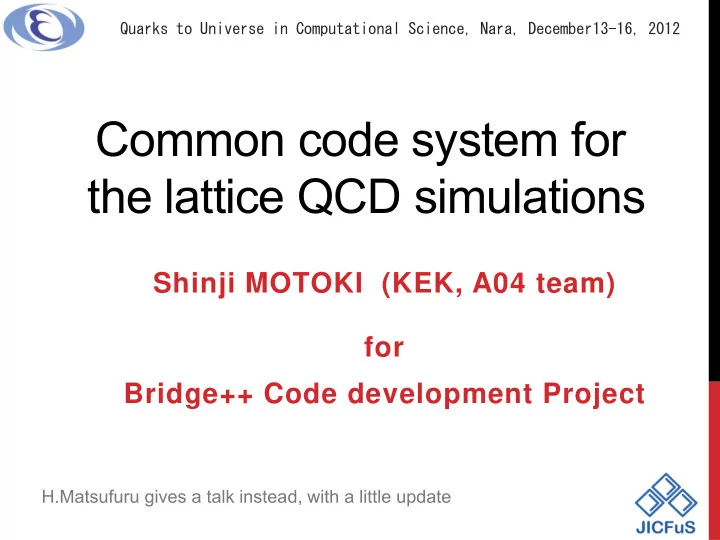

Quarks to Universe in Computational Science, Nara, December13-16, 2012 Common code system for the lattice QCD simulations Shinji MOTOKI (KEK, A04 team) for Bridge++ Code development Project H.Matsufuru gives a talk instead, with a little update
MEMBERS S. Aoki, T. Aoyama, G. Cossu, T. Doi, S. Hashimoto, N. Ishii, K-I. Ishikawa, K. Kanaya, T. Kaneko, Y . Kuramashi, H. Matsufuru, S. Motoki, Y . Namekawa, H. Nemura, J. Noaki, K. Ogawa, H. Saito, S. Sasaki, Y . Taniguchi, S. Ueda, N. Ukita, T. Yoshie. Also advised by H.Tadano, A.Imakura, Seminars by M.Sato and A.Nakamura Programmers, reviewers and users are wanted. Any interested people are welcome anytime!
SUPPORTED BY Grant-in-Aid for Scientific Research on Innovative Areas “Research on the Emergence of Hierarchical Structure of Matter by Bridging Particle, Nuclear and Astrophysics in Computational Science” The A04 team “Interdisciplinary algorithms and computer simulations” http://bridge.kek.jp/A04/ (H. Matsufuru's talk) HPCI Strategic Program Field 5 “The origin of matter and the universe” http://www.jicfus.jp – So far 60 meetings held every 1-2 weeks – Advices given by experts in computer science and applied mathematics
DEVELOPMENT POLICY ● Portability: running on various environment, from notebook PC to supercomputers ● High performance: fully making use of wide range of architecture, with state of the art techniques ● Easy to understand even for beginners ● Easy to extend to test new ideas
WHY COMMON CODE? ● Research environment may changes Collaboration members frequently come and go. – who maintains the code? – communication problem might occur. Machine architecture may change. – have to rewrite a new code for updated machines? ● Demands for “standard” Users should concentrate on their physics projects Generated data can be shared by different groups. Common language on the calculations is convenient. ● Why not using existing codes? E.g. Chroma and CPS++ are widely used in the community. We want a code completely under control of ourselves from foundation – Quick response to user’s requests --Detailed documentation and consulting service –Accumulating experiences of the development is important. to keep technology
PROFILE Our aim: well-organized portable code with a good performance, allowing beginners to carry out “professional simulations” C++ language: Design by the object oriented programming Stick to the standard libraries for portability Parallelized with MPI Documentation Doxygen is helpful: comments embedded in the code Detailed manual in English/Japanese Covering all basic calculations in Lattice QCD: Gauge configuration generation + measurements Commonly used lattice fermions ILDG data format Maximum flexibility in simulation parameters
WH AT H AV E BEEN I M PLEM EN T ED Ver.1.0 public release 24 July 2012 ● Gauge action: Plquette, Rectangular ● Fermion action: Wilson, Clover, staggered, overlap, domain-wall ● Link smearing: APE or HYP x stout (+ projection) ● Linear solvers: CG,BiCGStab, GMRES, etc. + shift solver(CG) ● Eigen solvers: Implicitly restarted Lanczos (for Hermitan matrix) ● HMC: multi-time step, Hasenbusch, Omelyan integrator, Rational HMC ● Gauge fixing: (Coulomb, Landau) ● Schrodinger functional boundaries, isospin chemical potential ● meson/baryon correlators (Dirac/chiral spinor representations) ● Wilson loop, Polyakv loop, etc. ● ILDG format is supported in configuration data I/O ● Now in progress: multi-thread (openMP or pthread ?), GPU (OpenCL)
DESIGN ● Example: solver and fermion operator Class diagram: relation between classes Solver does not distinguish which fermion operators: Fopr (base class) defines interface (virtual method) Solver Fopr solve() mult() Virtual base class defines Virtual base class solver interface defines fermion operator interface Fopr_Wilson Solver_CG mult() solve() Inherit class Inherit class Fopr_overlap Solver_BiCGStab implement each implements each fermion operator mult() solve() practical algorithm
CONFIRMATION ● Example of comparison to literature Reference: BMW Colab. JHEP 1108(2011) 148 Nf=2+1, 2 stout-HYP (2HEX), 16 3 x32 lattice BG/Q @KEK, 3% of peak performance, flat MPI for all the cores
DEVELOPMENT Trac/Subversion: joint development by the version control system Subversion : version control system of code set trac : project control system Organized information using the wiki ← screen shot (trac) ↓ repository browser
WEB SITE ● Source Code ● Release information ● Progress of development ● Manuals / User’s guide ● Confirmation reports etc. Please access to http://suchix.kek.jp/bridge/Lattice-code/ (Japanese only now)
DOCUMENTATION ● First-step guide, implementation note, etc. ● doxygen Class lis t function of each Classes
ROAD MAP ● Action/Algorithms to be implemented - Now Wilson/clover fermons are available in public version - Staggered (standard), domain-wall, overlap fermions are almost ready ● Improvement of design - General gauge group, fermion representations ● Performance tuning - On Hitachi SR, about 5% - On IBM Blue Gene/Q, less than 5% --- being improved - Shared memory parallelization - Framework to use accelerators: next page
ACCELERATORS ● General framework to use various accelerators (GPGPU, Cell B.E., MIC, etc.) We employ OpenCL (implemented, now being tuned) -- Open Computing Language (OpenCL) is a framework for writing programs that execute across heterogeneous platforms consisting of central processing units (CPUs), graphics processing units (GPUs), DSPs and other processors.
SUMMARY New lattice QCD code Bridge++ has been developed aiming at: ● Developing research environment − to skip unnecessary efforts of coding while getting high performance − to remove barriers of communication between researches/beginners − to share experiences, ideas and data ● Making use of knowledge of different fields − applied mathematics (algorithms) − computer science. software design One of the goals of this program The project is still in the early stage. We strongly need your suggestions, contributions, and feedbacks
DEMONSTRATION
Thank you for your attention. http://suchix.kek.jp/bridge/Lattice-code/ Quarks to Universe in Computational Science, Nara, December13-16, 2012
Recommend
More recommend